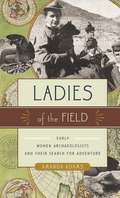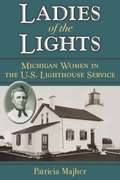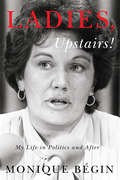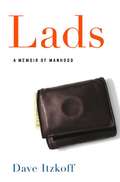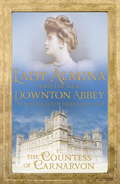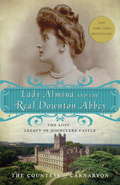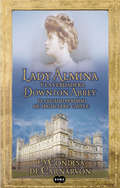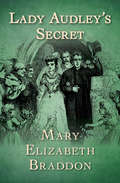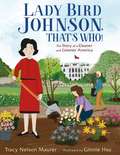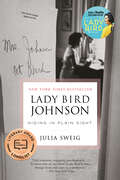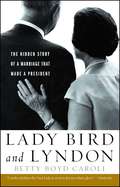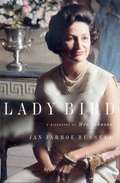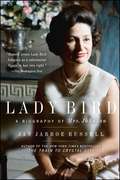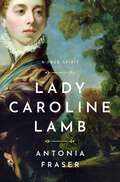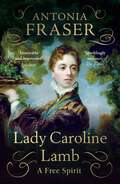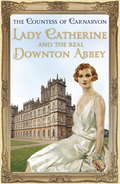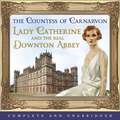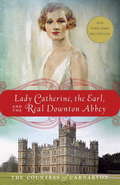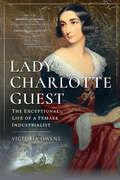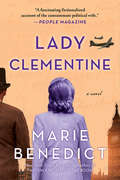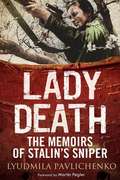- Table View
- List View
Ladies of the Field: Early Women Archaeologists and Their Search for Adventure
by Amanda AdamsThe first women archaeologists were Victorian era adventurers who felt most at home when farthest from it. Canvas tents were their domains, hot Middle Eastern deserts their gardens of inquiry and labor. <P><P>Thanks to them, prevailing ideas about feminine nature - soft, nurturing, submissive - were upended. Ladies of the Field tells the story of seven remarkable women, each a pioneering archaeologist, each headstrong, smart, and courageous, who burst into what was then a very young science. Amanda Adams takes us with them as they hack away at underbrush under a blazing sun, battle swarms of biting bugs, travel on camelback for weeks on end, and feel the excitement of unearthing history at an archaeological site. Adams also reveals the dreams of these extraordinary women, their love of the field, their passion for holding the past in their hands, their fascination with human origins, and their utter disregard for convention.
Ladies of the Lights: Michigan Women in the U.S. Lighthouse Service
by Patricia Majher"A great read about some great ladies, Pat Majher'sLadies of the Lightspays long overdue homage to an overlooked part of Great Lakes maritime history in which a select group of stalwart women beat the odds to succeed in a field historically reserved for men. " ---Terry Pepper, Executive Director of Great Lakes Lighthouse Keeper's Association Michigan once led the country in the number of lighthouses, and they're still a central part of the mystique and colorful countryside of the state. What even the region's lighthouse enthusiasts might not know is the rich history of female lighthouse keepers in the area. Fifty women served the sailing communities on Lakes Huron, Michigan, and Superior, as well as on the Detroit River, for more than 100 years. From Catherine Shook, who raised eight children while maintaining the Pointe Aux Barques light at the entrance to Saginaw Bay; to Eliza Truckey, who assumed responsibility for the lighthouse in Marquette while her husband fought for four years in the Civil War; to Elizabeth Whitney, whose combined service on Beaver Island and in Harbor Springs totaled forty-one years---the stories of Michigan's "ladies of the light" are inspiring. This is no technical tome documenting the minutiae of Michigan's lighthouse specifications. Rather, it's a detailed, human portrait of the women who kept those lighthouses running, defying the gender expectations of their time. Patricia Majher is Editor ofMichigan Historymagazine, published by the Historical Society of Michigan. Prior, she was Assistant Director of the Michigan Women's Historical Center and Hall of Fame in Lansing, Michigan. In addition, she has been writing both advertising and editorial copy for almost thirty years and has been a frequent contributor to Michigan newspapers and magazines.
Ladies, Upstairs!: My Life in Politics and After
by Bob Rae Monique BéginMore than fifty years after most Canadian women received the right to vote, very few women were elected as members of Parliament and none came from Quebec. Canada's 1972 federal election marked a refreshing transition. Twice as many female candidates ran for office than in the previous election, and, of the five women elected to the House of Commons that year, three Liberal Party candidates – Monique Bégin, Albanie Morin, and Jeanne Sauvé – shared the honour of being the first Quebec women MPs. In this riveting memoir of a trailblazing female politician, Monique Bégin tells the story of her journey into politics and beyond. Born in Italy, Bégin spent her childhood in France and Portugal before arriving in Montreal as a refugee of the Second World War. In 1967, she was swept into the world of politics when she became executive secretary of the Royal Commission on the Status of Women. Inspired by Pierre Trudeau, she then ran for the House of Commons and served in various cabinet positions, ultimately spearheading the landmark Canada Health Act before retiring to pursue a career in academia. Offering a revealing glimpse into the pervading sexism of Canadian public life, Ladies, Upstairs! details the experiences of a feisty, candid outsider who, through sheer fortitude, intelligence, and hard work, became minister of health and welfare, a university dean, a sought-after member for commissions of inquiry, and an international expert on public health. The voice of a woman in a male world, a francophone among anglophones, and a skeptical politician, Ladies, Upstairs! provides a fascinating account of one of Canada's most impressive federal ministers and her discoveries through the decades.
Ladies, Upstairs!: My Life in Politics and After
by Monique BéginMore than fifty years after most Canadian women received the right to vote, very few women were elected as members of Parliament and none came from Quebec. Canada's 1972 federal election marked a refreshing transition. Twice as many female candidates ran for office than in the previous election, and, of the five women elected to the House of Commons that year, three Liberal Party candidates – Monique Bégin, Albanie Morin, and Jeanne Sauvé – shared the honour of being the first Quebec women MPs. In this riveting memoir of a trailblazing female politician, Monique Bégin tells the story of her journey into politics and beyond. Born in Italy, Bégin spent her childhood in France and Portugal before arriving in Montreal as a refugee of the Second World War. In 1967, she was swept into the world of politics when she became executive secretary of the Royal Commission on the Status of Women. Inspired by Pierre Trudeau, she then ran for the House of Commons and served in various cabinet positions, ultimately spearheading the landmark Canada Health Act before retiring to pursue a career in academia. Offering a revealing glimpse into the pervading sexism of Canadian public life, Ladies, Upstairs! details the experiences of a feisty, candid outsider who, through sheer fortitude, intelligence, and hard work, became minister of health and welfare, a university dean, a sought-after member for commissions of inquiry, and an international expert on public health. The voice of a woman in a male world, a francophone among anglophones, and a skeptical politician, Ladies, Upstairs! provides a fascinating account of one of Canada's most impressive federal ministers and her discoveries through the decades.
Lads Before the Wind: Adventures in Porpoise Training
by Karen Pryor Konrad LorenzIn this book the reader learns almost as much about human behavior as about porpoise behavior. Starting from scratch, with a report on operant conditioning in one hand and a bucket of fish in the other, Karen Pryor learned to train porpoises, learned to train trainers, and gradually came to be recognized as an international authority on whale and porpoise behavior and training. Lads Before the Wind takes its title from Herman Melville ("They are the lads that always live before the wind. They are accounted a lucky omen"). Karen Pryor draws on her eight years as head trainer at Hawaii's Sea Life Park and Oceanic Institute. Working with entirely new species of whales and porpoises (at least new for training purposes), she and her team pioneered in logical and behavioral research.
Lads: A Memoir of Manhood
by Dave Itzkoff"What I wanted after college was a job and my own apartment, but what I needed was a good comeuppance, and that's what I got." When Dave Itzkoff graduated from Princeton in 1998--the first member of his family to earn a college degree--he expected to be rewarded with a career, and a life, that mattered. Instead, he ended up convinced that he was selling the entire institution of manhood down the river. After a series of personal and professional experiences stripped him of any lingering sense of entitlement, Itzkoff found himself working as an editor at Maxim, the pugnacious frontrunner in a new breed of men's periodicals dubbed "lad magazines." There, he was initiated into a culture of heavily retouched girlie pictorials, dirty jokes, disingenuous sex advice, and shopping guides for expensive electronic gadgetry. And as Maxim continued its inexorable rise to become the most successful men's magazine in modern publishing history, Itzkoff was left wondering what his work-and his life-really meant. Lads is the hilarious, heartbreaking story of Dave Itzkoff's efforts to define himself as a man while working at a magazine that was purveying a vision of young manhood-a state of perpetual adolescence-that was seductive to all but viable for none. Lads takes us deep inside one young man's struggle with identity, responsibility, and sexuality, in an unsparingly candid account of how men really relate to one another, as fathers and sons, as employers and employees, as colleagues and friends. Lads is trenchant. Lads is perceptive. Lads is alarmingly funny. This is an unforgettable debut from a young writer of astounding talent.
Lady Almina and the Real Downton Abbey: The Lost Legacy of Highclere Castle
by Countess Of Carnarvon'Bright, breezy and unpretentious' Guardian'A loving and faithful portrait of Almina and her world' Countryfile magazine* * * * * *The story of the real Downton Abbey, told by Lady Fiona Carnarvon, chatelaine of Highclere Castle where the phenomentally successful TV series was filmed.Lady Fiona Carnarvon became the chatelaine of Highclere Castle - the setting of the hit series Downton Abbey - eight years ago. In that time she's become fascinated by the rich history of Highclere, and by the extraordinary people who lived there over the centuries. One person particularly captured Fiona's imagination - Lady Almina, the 5th Countess of Carnarvon. Almina was the illegitimate daughter of banking tycoon Alfred de Rothschild. She was his only daughter and he doted on her. She married the 5th Earl of Carnarvon, at 19, with an enormous dowry. At first, life at Highclere was a dizzying mix of sumptuous banquets for 500 and even the occasional royal visitor. Almina oversaw 80 members of staff - many of whom came from families who had worked at Highclere for generations. But when the First World War broke out, life at Highclere changed forever. History intervened and Almina and the staff of Highclere were thrown into one of the most turbulent times of the last century. Almina was forced to draw on her deepest reserves of courage in order to ensure her family, the staff and the castle survived. This is the remarkable story of a lost time. But Highclere remains and in this book, Fiona weaves Almina's journey and those of her family into the heritage and history of one of England's most exquisite Victorian castles.
Lady Almina and the Real Downton Abbey: The Lost Legacy of Highclere Castle
by Countess Of Carnarvon'Bright, breezy and unpretentious' Guardian'A loving and faithful portrait of Almina and her world' Countryfile magazine* * * * * *The story of the real Downton Abbey, told by Lady Fiona Carnarvon, chatelaine of Highclere Castle where the phenomentally successful TV series was filmed.Lady Fiona Carnarvon became the chatelaine of Highclere Castle - the setting of the hit series Downton Abbey - eight years ago. In that time she's become fascinated by the rich history of Highclere, and by the extraordinary people who lived there over the centuries. One person particularly captured Fiona's imagination - Lady Almina, the 5th Countess of Carnarvon. Almina was the illegitimate daughter of banking tycoon Alfred de Rothschild. She was his only daughter and he doted on her. She married the 5th Earl of Carnarvon, at 19, with an enormous dowry. At first, life at Highclere was a dizzying mix of sumptuous banquets for 500 and even the occasional royal visitor. Almina oversaw 80 members of staff - many of whom came from families who had worked at Highclere for generations. But when the First World War broke out, life at Highclere changed forever. History intervened and Almina and the staff of Highclere were thrown into one of the most turbulent times of the last century. Almina was forced to draw on her deepest reserves of courage in order to ensure her family, the staff and the castle survived. This is the remarkable story of a lost time. But Highclere remains and in this book, Fiona weaves Almina's journey and those of her family into the heritage and history of one of England's most exquisite Victorian castles.
Lady Almina and the Real Downton Abbey: The Lost Legacy of Highclere Castle
by The Countess of CarnarvonFull-color photographs included throughout.Lady Almina and the Real Downton Abbey tells the story behind Highclere Castle, the real-life inspiration and setting for Julian Fellowes's Emmy Award-winning PBS show, and the life of one of its most famous inhabitants, Lady Almina, the 5th Countess of Carnarvon. Drawing on a rich store of materials from the archives of Highclere Castle, including diaries, letters, and photographs, the current Lady Carnarvon has written a transporting story of this fabled home on the brink of war. Much like her Masterpiece Classic counterpart Lady Cora Crawley, Lady Almina was the daughter of a wealthy industrialist, Alfred de Rothschild, who married his daughter off at a young age, her dowry serving as the crucial link in the effort to preserve the Earl of Carnarvon's ancestral home. Throwing open the doors of Highclere Castle to tend to the wounded of World War I, Lady Almina distinguished herself as a brave and remarkable woman. This rich tale contrasts the splendor of Edwardian life in a great house against the backdrop of the First World War and offers an inspiring and revealing picture of the woman at the center of the history of Highclere Castle.
Lady Almina y la verdadera Downton Abbey: El legado perdido de Highclere Castle
by Lady Fiona CarnarvonLady Fiona Carnarvon, la octava condesa, relata la extraordinaria historia del auténtico Downton Abbey, aún más fascinante que la ficción. Lady Fiona Carnarvon se convirtió en señora de Highclere Castle -escenario de la exitosa serie Downton Abbey- hace ocho años. En este periodo ha llegado a sentir fascinación por la interesante historia de Highclere y por las extraordinarias personas que han residido allí a lo largo de los siglos. Pero una persona en particular captó el interés de Fiona: lady Almina, la quinta condesa de Carnarvon. Almina fue la hija ilegítima del magnate de la banca Alfred de Rothschild. Fue su única hija y objeto de devoción por su parte. A los diecinueve años, con una inmensa dote, se casó con el quinto conde de Carnarvon. Al principio, la vida en Highclere transcurrió en una vertiginosa sucesión de suntuosos banquetes para quinientas personas e incluso algún que otro invitado real. Almina supervisó a ochenta empleados, muchos de los cuales procedían de familias que llevaban generaciones trabajando en Highclere. Pero el estallido de la Primera Guerra Mundial cambió para siempre la vida en Highclere, tanto arriba como abajo. Los avatares de la historia hicieron que Almina y el personal de Highclere se vieran envueltos en uno de los periodos más turbulentos del pasado siglo. Almina tuvo que hacer acopio de todo su arrojo para garantizar la supervivencia de su familia, del personal y del castillo. Esta es la extraordinaria historia de una época desaparecida. Sin embargo, Highclere permanece y en este libro lady Carnarvon narra la andadura de Almina y de su familia, el legado y la historia de una de las casas solariegas victorianas más exquisitas de Inglaterra.
Lady Audley's Secret
by Mary Elizabeth BraddonA barrister becomes a detective when his friend disappears at an English manor in this classic Victorian novel. Beautiful Lucy Graham charms every man she meets, including wealthy widower Sir Michael Audley. After they marry, he refurbishes his mansion to create a little palace for his new wife, where her future seems bright. Her past, however, is shrouded in darkness, and she&’ll do whatever it takes to keep it hidden. Then Sir Michael&’s nephew, Robert, a London barrister, comes for a visit with his good friend George Talboys for a week of fishing. But when George mysteriously vanishes, there&’s no time to relax. Increasingly suspicious of his new aunt, Robert searches for clues, determined to find his friend and discover exactly who Lady Audley really is. One of the most popular examples of the &“sensation novel&” craze that swept England during the nineteenth century, Lady Audley&’s Secret is said to reflect themes from a real-life crime of the era, the notorious Constance Kent case.
Lady Bird Johnson, That's Who!: The Story of a Cleaner and Greener America
by Tracy Nelson MaurerLady Bird Johnson, That's Who! is Tracy Nelson Maurer's lively picture book biography of Lady Bird Johnson, with a focus on her environmentalist passion and legacy as First Lady.Who fought to stop pollution? Who helped make America cleaner and greener? Lady Bird Johnson, That's Who!Claudia Alta Taylor was a lonely girl, shy as a butterfly growing up in Texas. She never dreamed she'd blossom into a visionary leader whose love for wildflowers, beautiful landscapes, and building community compelled her to lead the effort to combat pollution in the United States. A lifelong environmentalist, Lady Bird Johnson embraced her platform as First Lady to promote policy that beautified America’s roadways, waterways and parks, inspiring people to take pride in the places they live.With elements of women’s history, civics, and conservationism, this is a timely and informative picture book biography.
Lady Bird Johnson: Hiding in Plain Sight
by Julia SweigA magisterial portrait of Lady Bird Johnson, and a major reevaluation of the profound yet underappreciated impact the First Lady's political instincts had on LBJ’s presidency. <P><P>In the spring of 1964, President Lyndon B. Johnson had a decision to make. Just months after moving into the White House under the worst of circumstances—following the assassination of President John F. Kennedy—he had to decide whether to run to win the presidency in his own right. He turned to his most reliable, trusted political strategist: his wife, Lady Bird Johnson. The strategy memo she produced for him, emblematic of her own political acumen and largely overlooked by biographers, is just one revealing example of how their marriage was truly a decades-long political partnership. <P><P>Perhaps the most underestimated First Lady of the twentieth century, Lady Bird Johnson was also one of the most accomplished and often her husband's secret weapon. Managing the White House in years of national upheaval, through the civil rights movement and the escalation of the Vietnam War, Lady Bird projected a sense of calm and, following the glamorous and modern Jackie Kennedy, an old-fashioned image of a First Lady. In truth, she was anything but. As the first First Lady to run the East Wing like a professional office, she took on her own policy initiatives, including the most ambitious national environmental effort since Teddy Roosevelt. <P><P>Occupying the White House during the beginning of the women's liberation movement, she hosted professional women from all walks of life in the White House, including urban planning and environmental pioneers like Jane Jacobs and Barbara Ward, encouraging women everywhere to pursue their own careers, even if her own style of leadership and official role was to lead by supporting others. Where no presidential biographer has understood the full impact of Lady Bird Johnson’s work in the White House, Julia Sweig is the first to draw substantially on Lady Bird’s own voice in her White House diaries to place Claudia Alta "Lady Bird” Johnson center stage and to reveal a woman ahead of her time—and an accomplished politician in her own right. <P><P><b>A New York Times Best Seller</b>
Lady Bird and Lyndon: The Hidden Story of a Marriage That Made a President
by Betty Boyd CaroliA fresh look at Lady Bird Johnson that upends her image as a plain Jane who was married for her money and mistreated by Lyndon. This Lady Bird worked quietly behind the scenes through every campaign, every illness, and a trying presidency as a key strategist, fundraiser, barnstormer, peacemaker, and indispensable therapist.Lady Bird grew up the daughter of a domineering father and a cultured but fragile mother. When a tall, pushy Texan named Lyndon showed up in her life, she knew what she wanted: to leave the rural Texas of her childhood and experience the world like her mother dreamed, while climbing the mountain of ambition she inherited from her father. She married Lyndon within weeks, and the bargain they struck was tacitly agreed upon in the courtship letters they exchanged: this highly gifted politician would take her away, and she would save him from his weaknesses. The conventional story goes that Lyndon married Lady Bird for her money, demeaned her by flaunting his many affairs, and that her legacy was protecting the nation's wildflowers. But she was actually a full political partner throughout his ascent--the one who swooped in to make the key call to a donor, to keep the team united, to campaign in hostile territory, and to jumpstart him out of his paralyzing darkness. And while others were shocked that she put up with his womanizing, she always knew she had the upper hand. Lady Bird began the partnership by using part of her nest egg to help finance Lyndon's first political campaign. Over and over, she kept him from quitting, including the 1948 election when he was so immobilized with self-pity that she had to pick up the phone to solicit donations on his behalf. She was also the one who got him out of bed, when he was in a deep funk, to go to the 1964 Democratic nominating convention. In Lady Bird and Lyndon, Betty Boyd Caroli restores Lady Bird to her rightful place in history, painting a vivid portrait of a marriage with complex, but familiar and identifiable overtones.
Lady Bird: A Biography of Mrs. Johnson
by Jan Jarboe RussellLong obscured by her husband's shadow, Claudia "Lady Bird" Johnson emerges in this first comprehensive biography as a figure of surprising influence and the centering force for LBJ, a man who suffered from extreme mood swings and desperately needed someone to help control his darker impulses. Expertly researched and written, Lady Bird draws from rare conversations with the former First Lady and from interviews with key members of Johnson's inner circle of friends, family, and advisers. With chapters such as "Motherless Child," "A Ten- Week Affair," and "LBJ's Midlife Crisis," Lady Bird sheds new light on Mrs. Johnson's childhood, on her amazing acumen as a businesswoman, and on the central role she played in her husband's life and political career. A vital link to the Kennedys during LBJ's uneasy tenure as vice president and a voice of conscience on civil rights, Lady Bird is portrayed here as a political force, strikingly different from the somewhat minor figure depicted in previous works on LBJ. Especially fascinating today, in light of the enormous attention now focused on the private lives of our leaders, are the personal details about her marriage to a man whose extramarital affairs were widely discussed. In this intimate portrait, Russell shows us the private Lady Bird-not only a passionate conservationist but a remarkable woman who greatly influenced her husband, his administration, and the country.
Lady Bird: A Biography of Mrs. Johnson (Biography Ser.)
by Jan Jarboe RussellA revealing biography of Lady Bird Johnson with startling new insights into her marriage to Lyndon Baines Johnson and her unexpectedly strong impact on his presidency. Long obscured by her husband's shadow, Claudia "Lady Bird" Johnson emerges in this first comprehensive biography as a figure of surprising influence and the centering force for LBJ, a man who suffered from extreme mood swings and desperately needed someone to help control his darker impulses. Expertly researched and written, Lady Bird draws from rare conversations with the former First Lady and from interviews with key members of Johnson's inner circle of friends, family, and advisers. With chapters such as "Motherless Child," "A Ten-Week Affair," and "LBJ's Midlife Crisis," Lady Bird sheds new light on Mrs. Johnson's childhood, on her amazing acumen as a businesswoman, and on the central role she played in her husband's life and political career. A vital link to the Kennedys during LBJ's uneasy tenure as vice president and a voice of conscience on civil rights, Lady Bird is portrayed here as a political force, strikingly different from the somewhat minor figure depicted in previous works on LBJ. Especially fascinating today, in light of the enormous attention now focused on the private lives of our leaders, are the personal details about her marriage to a man whose extramarital affairs were widely discussed. In this intimate portrait, Russell shows us the private Lady Bird -- not only a passionate conservationist but a remarkable woman who greatly influenced her husband, his administration, and the country.
Lady Caroline Lamb: A Free Spirit
by Antonia FraserThe vivid and dramatic life of Lady Caroline Lamb, whose scandalous love affair with Lord Byron overshadowed her own creativity and desire to break free from society's constraints.From the outset, Caroline Lamb had a rebellious nature. From childhood she grew increasingly troublesome, experimenting with sedatives like laudanum, and she had a special governess to control her. She also had a merciless wit and talent for mimicry. She spoke French and German fluently, knew Greek and Latin, and sketched impressive portraits. As the niece of Georgiana, Duchess of Devonshire, she was already well connected, and her courtly skills resulted in her marriage to the Hon. William Lamb (later Lord Melbourne) at the age on nineteen. For a few years they enjoyed a happy marriage, despite Lamb's siblings and mother-in-law detesting her and referring to her as "the little beast." In 1812 Caroline embarked on a well-publicised affair with the poet Lord Byron - he was 24, she 26. Her phrase "mad, bad and dangerous to know" became his lasting epitaph. When he broke things off, Caroline made increasingly public attempts to reunite. Her obsession came to define much of her later life, as well as influencing her own writing - most notably the Gothic novel Glenarvon - and Byron's. Antonia Fraser's vividly compelling biography animates the life of 'a free spirit' who was far more than mad, bad and dangerous to know.
Lady Caroline Lamb: A Free Spirit
by Lady Antonia FraserFrom the outset, Caroline Lamb had a rebellious nature. From childhood she grew increasingly troublesome, experimenting with sedatives like laudanum, and she had a special governess to control her. She also had a merciless wit and talent for mimicry. She spoke French and German fluently, knew Greek and Latin, and sketched impressive portraits. As the niece of Georgiana, Duchess of Devonshire, she was already well connected, and her courtly skills resulted in her marriage to the Hon. William Lamb (later Lord Melbourne) at the age on nineteen. For a few years they enjoyed a happy marriage, despite Lamb's siblings and mother-in-law detesting her and referring to her as 'the little beast'. In 1812 Caroline embarked on a well-publicised affair with the poet Lord Byron - he was 24, she 26. Her phrase 'mad, bad and dangerous to know' became his lasting epitaph. When he broke things off, Caroline made increasingly public attempts to reunite. Her obsession came to define much of her later life, as well as influencing her own writing - most notably the Gothic novel Glenarvon - and Byron's. Antonia Fraser's vividly compelling biography animates the life of 'a free spirit' who was far more than mad, bad and dangerous to know.
Lady Catherine and the Real Downton Abbey
by The Countess Of Carnarvon**Explore the fascinating history of the real Downton Abbey as the Crawley family saga makes its way on to the big screen with Downton Abbey, the major motion picture**'An excellent depiction of English aristocratic life ... a compelling portrait' Publisher's Weekly* * * * * *The follow-up to the international bestseller Lady Almina and the Real Downton Abbey, this book moves the story into the 1920s, and focuses on the remarkable American heiress who came to reign at Highclere Castle.Sometimes the facts are even more extraordinary than the fiction ... This book tells the story of Lady Catherine, a beautiful American girl who became the chatelaine of Highclere Castle, the setting for Julian Fellowes' award-winning drama Downton Abbey. Charming and charismatic, Catherine caught the eye of Lord Porchester (or 'Porchey', as he was known) when she was just 20 years old, and wearing a pale yellow dress at a ball. She had already turned down 14 proposals before she eventually married Porchey in 1922. But less than a year later Porchey's father died suddenly, and he became the 6th Earl of Carnarvon, inheriting a title and a Castle that changed both their lives forever. Catherine found herself suddenly in charge of a small army of household staff, and hosting lavish banquets and weekend house parties. Although the couple were very much in love, considerable challenges lay ahead for Catherine. They were immediately faced with the task of saving Highclere when debts threatened to destroy the estate. As the 1920s moved to a close, Catherine's adored brother died and she began to lose her husband to the distractions London had to offer. When the Second World War broke out, life at the Castle would never be the same again. Drawing on rich material from the private archives at Highclere, including beautiful period photographs, the current Countess of Carnarvon transports us back to the thrilling and alluring world of the 'real Downton Abbey' and its inhabitants.
Lady Catherine and the Real Downton Abbey
by The Countess Of Carnarvon**Explore the fascinating history of the real Downton Abbey as the Crawley family saga makes its way on to the big screen with Downton Abbey, the major motion picture**'An excellent depiction of English aristocratic life ... a compelling portrait' Publisher's Weekly* * * * * *The follow-up to the international bestseller Lady Almina and the Real Downton Abbey, this book moves the story into the 1920s, and focuses on the remarkable American heiress who came to reign at Highclere Castle.Sometimes the facts are even more extraordinary than the fiction ... This book tells the story of Lady Catherine, a beautiful American girl who became the chatelaine of Highclere Castle, the setting for Julian Fellowes' award-winning drama Downton Abbey. Charming and charismatic, Catherine caught the eye of Lord Porchester (or 'Porchey', as he was known) when she was just 20 years old, and wearing a pale yellow dress at a ball. She had already turned down 14 proposals before she eventually married Porchey in 1922. But less than a year later Porchey's father died suddenly, and he became the 6th Earl of Carnarvon, inheriting a title and a Castle that changed both their lives forever. Catherine found herself suddenly in charge of a small army of household staff, and hosting lavish banquets and weekend house parties. Although the couple were very much in love, considerable challenges lay ahead for Catherine. They were immediately faced with the task of saving Highclere when debts threatened to destroy the estate. As the 1920s moved to a close, Catherine's adored brother died and she began to lose her husband to the distractions London had to offer. When the Second World War broke out, life at the Castle would never be the same again. Drawing on rich material from the private archives at Highclere, including beautiful period photographs, the current Countess of Carnarvon transports us back to the thrilling and alluring world of the 'real Downton Abbey' and its inhabitants.
Lady Catherine and the Real Downton Abbey
by The Countess Of CarnarvonSometimes the facts are even more extraordinary than the fiction... This book tells the story of Lady Catherine, a beautiful American girl who became the chatelaine of Highclere Castle, the setting for Julian Fellowes' award-winning drama Downton Abbey. Charming and charismatic, Catherine caught the eye of Lord Porchester (or 'Porchey', as he was known) when she was just 20 years old, and wearing a pale yellow dress at a ball. She had already turned down 14 proposals before she eventually married Porchey in 1922. But less than a year later Porchey's father died suddenly, and he became the 6th Earl of Carnarvon, inheriting a title and a Castle that changed both their lives forever. Catherine found herself suddenly in charge of a small army of household staff, and hosting lavish banquets and weekend house parties. Although the couple were very much in love, considerable challenges lay ahead for Catherine. They were immediately faced with the task of saving Highclere when debts threatened to destroy the estate. As the 1920s moved to a close, Catherine's adored brother died and she began to lose her husband to the distractions London had to offer. When the Second World War broke out, life at the Castle would never be the same again. Drawing on rich material from the private archives at Highclere, including beautiful period photographs, the current Countess of Carnarvon transports us back to the thrilling and alluring world of the 'real Downton Abbey' and its inhabitants.(P)2013 Hodder & Stoughton
Lady Catherine, the Earl, and the Real Downton Abbey
by The Countess of CarnarvonLady Catherine, the Earl, and the Real Downton Abbey, a transporting companion piece to the New York Times bestseller Lady Almina and the Real Downton Abbey, tells the story of Catherine Wendell, the beautiful and spirited American woman who married Lady Almina's son, the man who would become the 6th Earl of Carnarvon. The couple presided over Highclere Castle, the grand estate that serves as the setting for the hit PBS show Downton Abbey. Following the First World War, many of the great houses of England faded as their owners fortunes declined in the new political and social world of the 1920s and 1930s. As war loomed, Highclere's survival as the family home of the Carnarvons was again in the balance--as was peace between the nations of Europe. Using copious materials--including diaries and scrapbooks--from the castle's archives, the current Countess of Carnarvon brings alive a very modern story in a beautiful and fabled setting, paying particular attention to the staff who provide Highclere Castle with continuity between generations.From the Trade Paperback edition.atherine's husband joined the navy while Porchey's new wife quickly left for America.Highclere Castle and the Estate were turned into homes for evacuee children as well as lodging for soldiers. Porchey joined the war effort as an army adjutant (later a liaison officer) and was commended by the Americans stationed near Highclere. Catherine and Porchey's son Henry also joined the war in 1943 and fought in Italy. Like other wives and mothers, Catherine endured the unbearable stress of waiting for news of two beloved people in her life. Using copious materials - including diaries and scrapbooks - from the castle's archive, the New York Times Bestselling author the Countess of Carnarvon brings alive a very modern story in a beautiful and famous setting, paying particular attention not just to the goings on upstairs, but also to the butler, footmen, and other staff whose lives downstairs kept the Castle moving forward into the twentieth century.From the Trade Paperback edition.
Lady Charlotte Guest: The Exceptional Life of a Female Industrialist (Trailblazing Women)
by Victoria OwensThe remarkable biography of a mother of ten who stepped up to run her late husband’s ironworks in Victorian Wales.When impoverished aristocrat Lady Charlotte Bertie married wealthy Welsh ironmaster John Guest of Dowlais in 1833, her relatives looked on with dismay. Yet despite their vast difference of background and age, over their nineteen-year long marriage husband and wife enjoyed great happiness and much adventure. There would be ten children, and while John built up an immense commercial empire, Charlotte championed Welsh culture.Crucially, she taught herself John’s business from the inside. Over the years, she made the keenest observation of iron production, the fluctuations of the trade, and the engineering innovations. When John died in 1852, she was therefore uniquely placed to succeed him as head of the works—a remarkable position for a Victorian woman. She endeavored to introduce reforms, but also—rather to her dismay—had to weather a potentially destructive strike.But success came at a price. With her star seemingly in the ascendant, Lady Charlotte suddenly chose to abandon all, leave Wales, and marry her sons’ tutor. This book traces the ardent, creative years of her first marriage, explores her determination to preserve John’s legacy as a widow, and observes her growing devotion to the scholarly Charles Schreiber.
Lady Clementine: A Novel
by Marie BenedictFrom Marie Benedict, the New York Times bestselling author of The Only Woman in the Room! An incredible novel that focuses on one of the people who had the most influence during World War I and World War II: Clementine Churchill. In 1909, Clementine steps off a train with her new husband, Winston. An angry woman emerges from the crowd to attack, shoving him in the direction of an oncoming train. Just before he stumbles, Clementine grabs him by his suit jacket. This will not be the last time Clementine Churchill will save her husband. Lady Clementine is the ferocious story of the ambitious woman beside Winston Churchill, the story of a partner who did not flinch through the sweeping darkness of war, and who would not surrender either to expectations or to enemies.Also by Marie Benedict: The Only Woman in the Room The Other Einstein Carnegie's MaidPraise for Lady Clementine:"Benedict is a true master at weaving the threads of the past into a compelling story for today. Here is the fictionalized account of the person who was the unequivocal wind beneath Winston Churchill's wings — a woman whose impact on the world-shaper that was WW2 has been begging to be told. A remarkable story of remarkable woman."—Susan Meissner, bestselling author of The Last Year of the War"The atmospheric prose of Marie Benedict draws me in every single time. Lady Clementine's powerful and spirited story is both compelling and immersive. Benedict fully inhabits the measured and intelligent voice of Clementine Churchill. Entranced throughout, I discovered the secrets behind a familiar story I thought I knew. Deftly moving from the early nineteen hundreds through World War II, Benedict skillfully paints a vivid picture of the times and life of Clementine, the remarkable woman who was the steady force beside Winston Churchill." —Patti Callahan Henry, New York Times bestselling author of Becoming Mrs. Lewis "In her latest novel, Lady Clementine, Marie Benedict has gifted us all with another thoughtful and illuminating behind-the-scenes look at one of history's most unusual and extraordinary women. Benedict stuns readers with a glorious assortment of Clementine Churchill's most personal secrets: her scandalous childhood, her unexpected role as a social outsider, her maternal insecurities, and the daily struggles she faces to smooth her husband's political blunders and to keep up with his relentless demands for guidance and attention. With a historian's eye and a writer's heart, Benedict provides an unforgettable glimpse into the private world of a brilliant woman whose impact and influence on world events deserves to be acknowledged."—Lynda Cohen Loigman, USA TODAY author of The Two-Family House and The Wartime Sisters
Lady Death: The Memoirs of Stalin's Sniper
by Lyudmila Mykhailvna PavlichenkoLyudmila Pavlichenko was one of the most successful – and feared – female snipers of all time. When Hitler launched Operation Barbarossa in June 1941 she left her university studies to join the Red Army. Ignoring offers of positions as a nurse she became part of Soviet Russia’s elite group of female snipers. Within a year she had 309 confirmed kills, including 29 enemy sniper kills. Renowned as the scourge of German soldiers, she was regarded as a key heroic figure for the war effort and, in 1942, on Stalin’s personal orders, she travelled as part of a Soviet delegation to the West, fundraising in Canada, Great Britain and the USA. Dubbed ‘Lady Death’, she spoke out about gender equality in the Red Army and made the case for the USA to continue the fight against the Nazis in Europe. The folk singer Woody Guthrie wrote a song about her exploits – ‘Miss Pavlichenko’ – and she visited the White House, where she formed an unlikely but long-lasting friendship with Eleanor Roosevelt. In November 1942 she visited Coventry and accepted donations of £4,516 from Coventry workers to pay for three X-ray units for the Red Army. She also visited a Birmingham factory as part of her fundraising tour.
